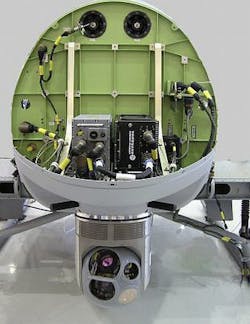Arête to build UAV multispectral sensor payload to protect attacking Marines from hidden mines
Officials of the Naval Surface Warfare Center Panama City Division in Panama City, Fla., announced a $11.7 million contract to Arête on Thursday to build one AN/DVS-1 drone-based coastal battlefield reconnaissance and analysis (COBRA) Block I system for the U.S. Navy littoral combat ship mine-countermeasures mission package.
COBRA uses multispectral sensors to conduct unmanned aerial tactical reconnaissance to detect and localize mine fields and obstacles in the surf zone and beach zone prior to amphibious assault.
The AN/DVS-1 COBRA passive multispectral sensor system is for daytime surface-laid mine line and obstacle detection in the beach zone, and has off-board processing, Arête experts say.
Carried on the Navy Northrop Grumman MQ-8B Fire Scout unmanned helicopter, the sensor system has limited detection capability in the surf zone. The system enables operators and personnel to remain at safe distances from mines and obstacles. COBRA will be deployed from the littoral combat ship and is an integral part of the ship's mine countermeasures mission package.
The COBRA payload includes stabilized step stare digital gimbal, high-resolution multispectral imaging digital camera with spinning six-color filter wheel, a processing unit, and a solid-state data storage unit.
The gimbal is about 19 inches long and 11 inches in diameter, and collects six different color-band images across a large area using a step-stare pattern. At the mission, personnel load its data storage unit into a post mission analysis station.
Related: Raytheon wins another contract for Multi-Spectral Targeting Systems for Navy helicopters
Arête Associates is prime contractor for engineering, manufacturing, production and delivery of several low rate initial production (LRIP) COBRA Block 1 systems. Company engineers developed COBRA as part of a Small Business Innovative Research (SBIR) Phase III contract.
The COBRA Block I system has two airborne payloads, the post mission analysis station, and the tactical control system segment for the UAV ground control station to plan the flight tracks for the COBRA mission, monitor the mission, and reprogram the flight path if necessary.
On this contract Arête Associates will do the work in Tucson, Ariz., and should be finished by February 2017. For more information contact Arête Associates online at www.arete.com, or the Naval Surface Warfare Center Panama City Division at www.navsea.navy.mil/nswc/panamacity.
